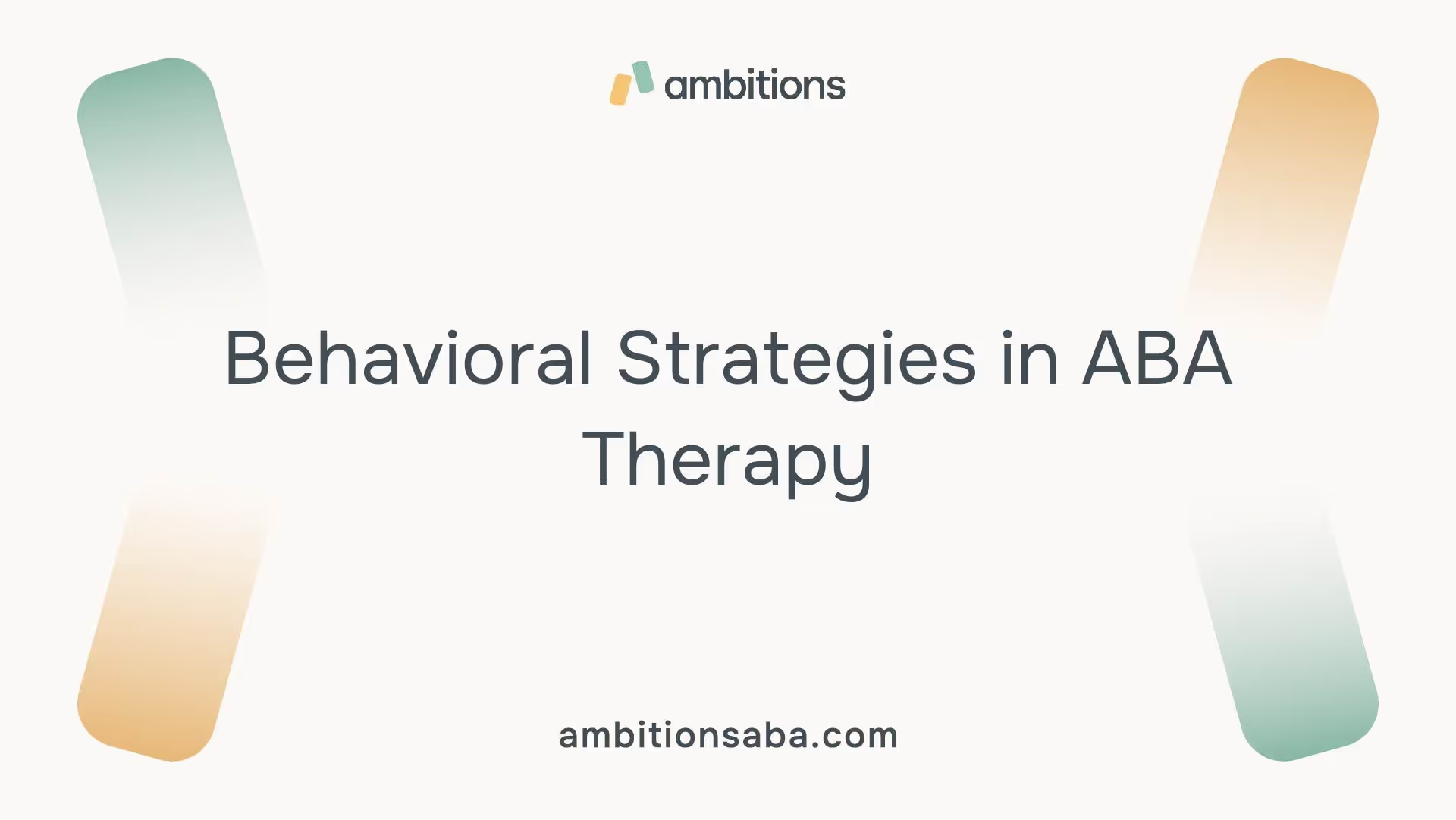Skills Taught in ABA Therapy
ABA therapy, a widely recognized approach in helping children with autism, focuses on teaching essential skills that enhance their daily lives. This section highlights two critical areas: Activities of Daily Living (ADL) training and social skills development.

Activities of Daily Living (ADL) Training
Activities of Daily Living (ADLs) encompass essential skills necessary for daily functioning, such as grooming, dressing, eating, and hygiene. ABA therapists employ behavior analysis principles to evaluate an individual's current capabilities regarding ADLs and design personalized intervention plans.
The goal of ADL training is to promote independence and improve functional abilities, thus enhancing the overall quality of life for individuals with autism or developmental disabilities [1]. Training is tailored to each person's age, developmental level, and unique objectives.
Type of ADLSkills TaughtGroomingBrushing teeth, combing hairDressingPutting on clothes, selecting appropriate outfitsEatingUsing utensils, understanding meal timesHygieneBathing, hand washing
For more information on how independence is built through ABA therapy, visit our article on how aba therapy builds independence?.
Social Skills Development
Social skills development is another crucial aspect of ABA therapy. ABA emphasizes the importance of teaching social skills to children with autism, focusing on areas like social play, communication, and understanding social cues [2].
The goal is to help children engage and interact meaningfully with their peers, leading to improved relationships and social integration. Through structured teaching and reinforcement, children learn essential social skills.
Social SkillStrategies UsedEye ContactReinforcement for sustained eye contactTurn-takingGames and structured activitiesAsking for HelpRole-playing and promptsRecognizing EmotionsIdentifying feelings through pictures
If you want to explore ways to enhance social skills specifically, check out our article on building social skills in autism.
Through ADL training and social skills development, ABA therapy plays a significant role in helping children with autism acquire essential skills for independent living and social engagement.

Behavioral Strategies in ABA Therapy
Applied Behavior Analysis (ABA) therapy employs various behavioral strategies that are effective in supporting children with autism. The following are key strategies utilized in ABA therapy: positive reinforcement, behavior analysis principles, and individualized assessment.
Positive Reinforcement
Positive reinforcement is a fundamental strategy used in ABA therapy. It encourages desired behaviors by rewarding those behaviors, reinforcing their occurrence in the future. Rewards can vary significantly and may include praise, toys, books, or access to playgrounds. Understanding how effective positive reinforcement can be is essential for parents looking to enhance their child's behavior.
Type of ReinforcerExamplesVerbal Praise"Great job!"Tangible RewardsToys, stickers, bookmarksActivitiesExtra playtime, access to favorite games
Behavior Analysis Principles
Behavior analysis principles guide ABA therapy by emphasizing the understanding and modification of behavior. The therapy focuses on developing social skills for children with autism, particularly in areas such as social play, social language, and social intuition [2]. Since the 1960s, ABA has aimed to increase positive behaviors while decreasing harmful ones, using observational data to apply these principles in real-life situations.
Goal of Behavior AnalysisDescriptionIncrease Helpful BehaviorsTeach and reinforce desirable actionsDecrease Harmful BehaviorsIdentify and reduce negative actions
Individualized Assessment
Individualized assessments are crucial in tailor-fitting ABA therapy to suit the needs of each child. A qualified behavior analyst, known as a BCBA (Board Certified Behavior Analyst), designs and oversees these programs. They conduct thorough assessments to determine the specific needs, skills, interests, and preferences of each learner. These assessments guide the creation of effective treatment goals that align with the child's unique profile.
Assessment ComponentPurposeSkills AssessmentIdentify strengths and areas for growthPreferences AssessmentTailor activities to the child’s interestsGoal SettingEstablish specific, measurable objectives
Through understanding the strategies involved in ABA therapy, parents can better support their children's growth. For more insights on supporting children with autism, check out our articles on parenting tips for children with autism and how ABA therapy benefits families?.
Teaching Social Skills in ABA Therapy
Teaching social skills is a crucial component of ABA therapy, especially for children diagnosed with autism. The aim is to help them navigate social situations, build relationships, and enhance their overall quality of life. Below, key aspects of teaching social skills through ABA therapy are explored.
Behavioral Skills Training
Behavioral skills training (BST) is an effective method for teaching social skills within the framework of ABA therapy. BST typically involves four key steps:
This structured approach allows children with autism to break down complex social interactions into manageable components, facilitating learning and retention of social skills. For more on parental strategies, visit our guide on building social skills in autism.
Curriculum for Social Skills
A comprehensive curriculum for teaching social skills in ABA therapy includes essential elements that many children with autism may struggle with. These elements encompass:
Social skills programs systematically break down these components, allowing children to learn and practice one aspect at a time. This methodology helps learners develop friendships and integrate more smoothly into classroom and community settings.
Key Elements of Social Skills CurriculumDescriptionTaking TurnsEncourages sharing and collaboration with peersConversation SkillsTeaches engaging dialogue and response techniquesUnderstanding Facial ExpressionsPromotes recognition of non-verbal communicationUnderstanding Tone of VoiceAids in interpreting emotional context of conversations
Building a robust framework for social skills is vital. ABA therapy tailors these elements based on the individual needs of each child, including personal interests and experiences, thus making the training relevant to their lives. For additional guidance, consult our article on parenting tips for children with autism.
By emphasizing these strategies, ABA therapy allows children with autism to acquire valuable skills that enhance their social interactions and overall development.
ABA Therapy Implementation
ABA (Applied Behavior Analysis) therapy requires careful implementation to be effective. This includes utilizing a variety of procedures and properly training caregivers to ensure consistency and support for the child.
Procedure Variety in Therapy
In ABA therapy, a diverse array of procedures is utilized to facilitate learning and reinforce desired behaviors. Both the therapist and the individual with autism actively participate in this process, fostering a dynamic learning environment. This approach not only aids in skill acquisition but also encourages the generalization of learned behaviors across different settings.
A common method includes reinforcement systems, which teach children about the consequences of their actions. Techniques such as token systems allow children to earn tokens for exhibiting target behaviors. These tokens can then be exchanged for rewards, making the learning process engaging and motivating.
Procedure TypeDescriptionPositive ReinforcementRewards are provided for desired behaviors to increase their likelihood.Token SystemsChildren earn tokens for specific behaviors, which can be exchanged for rewards.Task AnalysisBreaking down behaviors into smaller, manageable steps for easier learning.
ABA therapists focus on identifying the antecedents (triggers), the behaviors, and the consequences of behaviors for every targeted change. This systematic approach allows for individualized strategies that cater to the unique needs of each child, promoting better outcomes.
Training for Caregivers
Training for caregivers is a critical component of ABA therapy. Parents, family members, and caregivers receive instruction on how to support the child’s learning and practice skills throughout daily activities. By involving caregivers in the training process, the child is more likely to achieve consistency in their progress, both within therapy sessions and in their everyday lives.
Caregivers learn to implement positive reinforcement effectively, ensuring that appropriate behaviors are encouraged in various settings. This training equips caregivers to recognize opportunities for practice and to reinforce skills outside the clinical environment.
Effective training focuses on the following key areas:
Training AspectDescriptionBehavior ReinforcementTeaching caregivers how to identify and reward desired behaviors effectively.Consistency TechniquesEquipping caregivers with strategies to ensure skill application in daily life.Support SystemsProviding guidance on how to create supportive environments for the child.
Through ongoing training and support, caregivers become vital partners in the success of ABA therapy, enhancing the child's development and fostering independence. For additional insights into how ABA therapy benefits families, explore our article on how aba therapy benefits families?.
Communication Skills in ABA Therapy
Effective communication is crucial in both social interactions and daily living. In ABA (Applied Behavior Analysis) therapy, several strategies are employed to help individuals enhance their communication skills, including task analysis, prompting and fading, and positive reinforcement.
Task Analysis
Task analysis is a fundamental component in ABA therapy. It involves breaking down complex tasks into smaller, manageable steps to ensure that the learner masters each component before moving on to the entire task. For instance, when teaching a child to brush their teeth, the task can be divided into distinct steps, such as:
This method allows for a clear understanding of each part of the process, facilitating learning [5].
Task ComponentStep Description1. Get toothbrushLocating and picking up the toothbrush2. Apply toothpasteSqueezing toothpaste onto the brush3. Brush teethMoving the toothbrush to clean teeth4. Rinse mouthSwishing water in the mouth and spitting out5. Put toothbrush awayReturning the toothbrush to its holder
Prompting and Fading
Prompting refers to the cues or assistance provided to help individuals complete tasks successfully. This step is essential in guiding learners through new skills. In ABA therapy, the aim is to gradually fade these prompts as the child becomes more proficient, ultimately enabling independent task completion. For example, initially, a therapist might verbally prompt a child to "grab your toothbrush." Over time, the therapist would decrease their assistance, allowing the child to perform the task independently.
Different types of prompts include:
Positive Reinforcement
Positive reinforcement is a core principle in ABA therapy that involves providing rewards or incentives to encourage desired behaviors. When a child successfully completes a task, such as washing their hands, they might receive verbal praise or a small reward, such as a favorite toy. This approach increases the likelihood of the desired behavior being repeated in the future.
Desired BehaviorType of ReinforcementSuccessfully washing handsPraise, stickers, or extra playtimeGreeting peersHigh-fives or small tokensCompleting homeworkSpecial treat
Implementing these communication skills through task analysis, prompting and fading, and positive reinforcement can significantly benefit children diagnosed with autism. This structured approach helps them build the necessary skills for improved communication, social interactions, and independence in daily activities. For more strategies on enhancing social skills, explore our article on building social skills in autism or visit our section on effective routines for autistic kids.
Generalization of Skills
Generalization is an important concept in Applied Behavior Analysis (ABA) therapy, especially for children diagnosed with autism. It refers to the ability to apply learned skills across different contexts, people, and environments. This is crucial for ensuring that the benefits of therapy extend beyond the therapy sessions and into everyday life.
Communication Skills Generalization
In ABA therapy, generalization of communication skills is vital. Therapists work with individuals to help them apply these skills in various settings and with different people. This could mean using communication strategies at home, in the community, or at school.
SettingSkill AppliedExampleHomeRequestingAsking for a snack during family mealsSchoolAnswering QuestionsResponding to a teacher’s questions in classCommunitySocial GreetingsSaying "hello" or "thank you" at the store
By practicing in diverse situations, individuals can build a more robust communication repertoire, enhancing their ability to interact with others. For further insights into fostering communication skills, parents may find useful tips on building social skills in autism.
Social Interaction Strategies
Effective social interaction strategies are another key aspect of generalization in ABA therapy. These strategies help individuals understand how to engage in conversations, take turns, and appropriately respond to social cues.
One effective method includes role-playing activities, allowing individuals to practice social interactions in a safe and supportive environment. Through repeated practice, children become more comfortable with various social situations.
Key techniques for enhancing social interaction include:
Incorporating these strategies into daily routines can significantly enhance a child's ability to navigate social situations. Parents can explore more actionable strategies in parenting tips for children with autism.
Combining effective communication and social interaction strategies equips children diagnosed with autism with the skills they need to thrive in various contexts, which is an essential goal of ABA therapy. Utilizing these strategies promotes confidence and independence as they engage with their environment.
References
[2]:
[3]:
[4]:
[5]:



